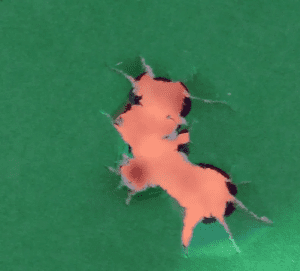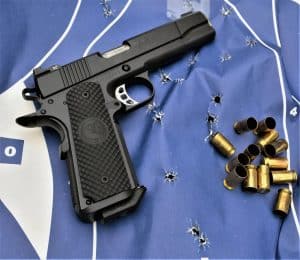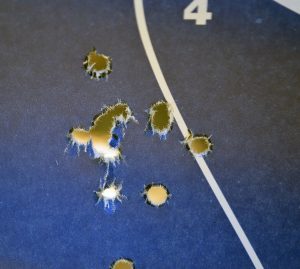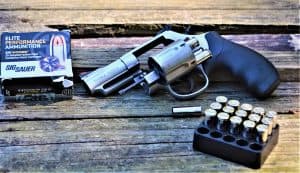For decades, I have been studying handguns and learned about terms like functional accuracy, inherent accuracy and absolute accuracy. Benchrest shooting is important and quite engaging. Nevertheless, absolute precision is not as essential as the practical precision that we can leverage from a gun.

In my opinion, riflemen take precision pretty seriously compared to handgun owners. Maybe it’s because many of them are not good enough at shooting to make the most of precision guns so they never mind. Competition tends to give more prominence to speed rather than precision, though the combination of those two is critical in self-defense.
The ideal precision we aim for
Shoot positioning is called precision. The accuracy measuring norm has come to be a five-stroke group at 25 yards. This is shot from a stable braced spot from a bench. I use the rest of the Bullshooter gun to eliminate the maximum number of human aspects. Some compromises are made with guns of a shorter barrel or lightweight. Thus they are checked at 15 yards.
Handgun quality, slide fitting, rifling quality, sights (whether good for target shooting or wide for quick fighting range results) are very critical. The trigger press should be of great quality. The most significant aspect of the equation is the gunman. Some might claim that such handgun testing is meaningless since the use of personal protection more often requires shooting at less than 10 yards. This claim has high credibility. It is not that combat firing, drawing, shooting and “hitting a center” is not challenging.

Checking an 8 3/8-inch barreled magnum at even 100 yards can be logical, except with a few exceptions, a self-protection handgun can never be used beyond 10 yards. Similarly, some of us who analyze handguns want to take them to the Nth degree to check the accuracy of the gun. Though there is some tension at first, It’s an exciting activity that is also rewarding.
The 1911 Nighthawk is debatably as effective as
An automatic .45.
There are varying standards of precision for service guns, high-end weapons, and revolvers. More precise than it should be is a revolver with five, six, seven or eight chambers that spin to match up with the barrel for every shot. As an example, with Federal Match ammo, the Colt Official Police .38 and the Smith and Wesson K 38 are both able to place five shots at 25 yards in 2.2 to 2.5 inches. This is an exceptional target precision.
These handguns were right for the job when cops equipped with revolvers at 50 yards. The Colt Python is probably the most precise revolver I’ve ever used and maybe the most precise handgun of any sort. I shot a 15/16-inch party with the Federal 148-grain MATCH in .38 Special at a long 25 yards. This required considerable focus and frankly said it was tiring.

I shot a similar group with the SIG P220, but it was different. For the Federal 230-grain MATCH loading, the SIG can typically go for 1.25-inch. With full-strength magnum loads, the Python can also group pretty nearly. For instance, the Federal 180-grain JHP .357 Magnum is fine for an inch at 25 yards. A revolver, being much less costly, is superbly precise and almost as precise as the Python. Ruger GP100 with the four-inch barrel is around 90 percent as strong as the Python for groups. It is more durable as well.
Practically possible great precision
Models of 1911 are a whole different matter. You pay a lot for the final degree of accuracy, as I have witnessed with many 1911 handguns. The Les Baer Concept VI is a powerful three-inch pistol at 50 yards for self-loaders. The SIG P220 is not as fast as a 1911 pistol, I said, but it’s more precise than all but the finest custom firearms. A well-made and accurate shotgun with a fair price is the Nighthawk Falcon.
The Guncrafter Commander (without a name) is one of the most reliable firearms of all kinds I’ve ever tested from 1911 handguns. So far the Fiocchi 200-grain XTP with a 25-yard 1.4-inch unit demonstrated the most precise loading though it needs a lot of focus to do this. This pistol is however one of the most precise firearms for offhand shooting. The gun is remarkably accurate when shot off-hand in visible and invisible ranges.

About the latest handguns, it is odd that there appears to be a competition in both directions—up and down. Manufacturers are working to make the cheapest possible handgun that functions. Somebody buys it, and some of the handguns, like the Ruger LC9/EDC models, are durable and useful handguns for self-defense.
To master your skills, the handgun should be often fired
The same story is with revolvers. Even the affordable Taurus 450 .45 caliber revolver I sometimes take hiking is enough to put five shots in less than two inches at 15 yards, which is acceptable for a revolver with a two-inch ported barrel. I’m displeased with the precision of several polymer-framed handguns. I think they’re accurate enough and that’s all but the trigger and the sights are definitely restricting the factory. Almost all fire five Service shots grade ammo in 2.5 to 3.0 inches at 25 yards.
The bulk of factory handguns from a previous generation lack preciseness, compared to high-end handguns, such as the Dan Wesson Heritage and Springfield Operator. For example, 39 years ago, I persuaded the lead trainer and range master to let us hold 1911.45. I hardly qualified for the Colt Commander Series 70 as the qualification contained a 50-yard barricade fire. With the factory ammo of the day, the pistol will not be clustered into 10 inches at 50 yards, the military norm for 1911 guns. The gun was bundled into eight inches at 50 yards, via 200-grain SWC handload, and I hardly made the cut.

The sights were narrow, the trigger was heavy, and the grip of the tang cut off my hand after 50 rounds. But the gun was accurate, quick in action, and it was a Colt 1911. Later, I added a Bar Sto barrel, and I enjoyed even improved precision. Today, the SIG 1911 Fastback Carry can group 5 bullets in 2.5 inches on call at 25 yards and often a ton less. Note, it’s a factory weapon!
This group was fired with the Beretta 84 .380 ACP
at 15 yards with a relative precision
Some other handguns are more precise than they are actually appreciated. While the SIG P series is considered to be a very precise handgun, the CZ 75B will challenge SIG with its quite competitive performance. The CZ 75B is easy to handle for off-hand shooting, plus – very precise. Yet another effective handgun is the Beretta 92 as I learned in the school of instructors when a veteran trained with the Beretta 92.

Despite some exceptions, the 40 caliber models of the 9mm are on the whole not as precise as the 9mm model. The SIG P229 in.40 is an efficient and precise firearm for going anywhere and doing anything. My case would put five rounds of Fiocchi-180 grain XTP load in 2.0 inches at 25 yards on request. Precision is fascinating but there are other things to consider, such as how fast the weapon can be tightened and aimed.
The Smith and Wesson M69 .44 Magnum and SIG Elite ammo are a
well-suited pair.
Control of rapid-fire is also essential. Reliability is far more critical than that yet precise handguns are extremely interesting.
What was the handgun that gave you the highest precision? Which one would you like to possess next? In the comment area, share your thoughts with us.